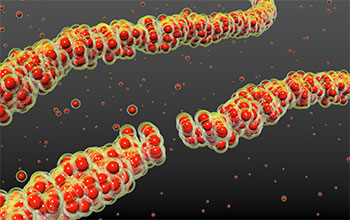Multimedia Gallery
Nanoparticles encased in oily liquid shells can bind together
Researchers found that magnetic nanoparticles encased in oily liquid shells can bind together in water to form flexible chains. The oil wets the particles and creates capillary bridges between them so that the particles stick together on contact. A magnetic field is added to arrange the nanoparticle chains and provide directionality.
[Research supported by U.S. National Science Foundation grant DMR 1121107.]
Learn more in the NC State news story Sandcastles inspire new nanoparticle binding technique. (Date image taken: 2015; date originally posted to NSF Multimedia Gallery: Jan. 6, 2016)
Credit: Bhuvnesh Bharti and Orlin Velev, Chemical and Biomolecular Engineering, North Carolina State University
See other images like this on your iPhone or iPad download NSF Science Zone on the Apple App Store.
Images and other media in the National Science Foundation Multimedia Gallery are available for use in print and electronic material by NSF employees, members of the media, university staff, teachers and the general public. All media in the gallery are intended for personal, educational and nonprofit/non-commercial use only.
Images credited to the National Science Foundation, a federal agency, are in the public domain. The images were created by employees of the United States Government as part of their official duties or prepared by contractors as "works for hire" for NSF. You may freely use NSF-credited images and, at your discretion, credit NSF with a "Courtesy: National Science Foundation" notation.
Additional information about general usage can be found in Conditions.
Also Available:
Download the high-resolution JPG version of the image. (1.1 MB)
Use your mouse to right-click (Mac users may need to Ctrl-click) the link above and choose the option that will save the file or target to your computer.



